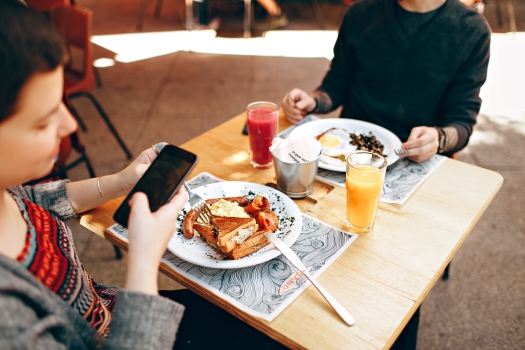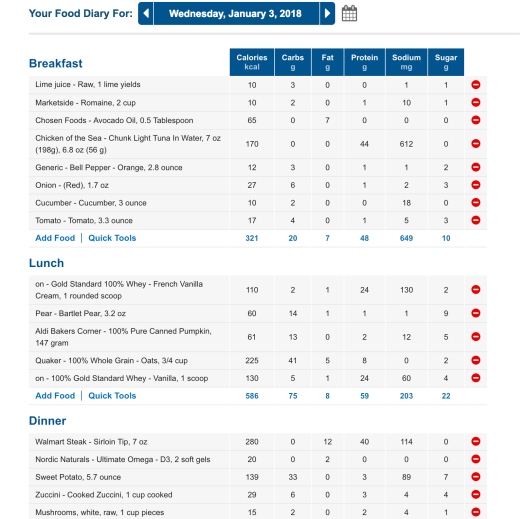In his book The Power of Habit, Charles Duhigg writes about the power of “keystone habits.” According to Duhigg, a keystone habit is a good habit that can create a chain reaction of other good habits. One of the most powerful keystone habits for health and wellness is tracking your food. As Duhigg explains, when you start writing down what you eat, you are more likely to make healthier food choices, manage calories, exercise more, and pay more attention to your health. Adding in this one small habit can lead to enormous positive changes.
If you want to improve your health this year, I recommend starting to log everything you eat and drink. Tracking your intake is tremendously helpful when trying to lose weight or change your body. This week’s post explains why food logging is so useful and provides a few options for getting started. In Part 2, I will give detailed instructions on how to use a food tracking app to get the most accurate picture of your daily intake.
Why log your food?
Tracking your food creates more awareness around what you eat and drink. Most people are woefully ignorant of how much they consume every day. It can be a truly eye-opening experience to see everything you eat and drink written down. I’ve had clients come back to me in shock after completing their first food log because they simply had no idea they were eating so much.
When you record everything you eat, you may also notice much of your eating and drinking happens subconsciously. This may take the form of mindless snacking in the breakroom, tasting meals as you cook, or clearing off the last bits of food on kids’ or partners’ plates. Although it doesn’t seem like much, repeating these behaviors day after day can lead to hundreds or thousands of unwanted calories each week.

Logging your food teaches you about the calorie and macronutrient content of your favorite foods and meals. Unfortunately, many of our favorite foods are deceptively high in calories. This is especially true of foods high in fat like peanut butter, nuts, and oils, as fat has over twice as many calories per gram as protein or carbs. It’s totally possible to sabotage a seemingly healthy diet by over consuming calorically dense foods. Logging helps you keep limit items to a reasonable amount.
Most Americans don’t know what a healthy portion size looks like. When you log your food, you can compare the visual of a proper serving size with the actual data. In time, this can also help you reconnect with your natural hunger cues. In my experience, the feeling of being satisfied is much more subtle than the feeling of being totally stuffed. If you have been eating poorly for so long that you can no longer recognize these cues, limiting yourself to a well-measured portion and then paying close attention to how you feel after the meal is an eye-opening experience.
Finally, logging your food keeps you accountable. Tracking helps you understand your current eating habits and provides the accountability and framework necessary to make positive changes. Additionally, logging your food can help you communicate with a coach or support group and allow you to troubleshoot when you hit the inevitable weight loss plateau.
How to log your food
There are three main options for food logging, each with pros and cons. Choose the option that fits best with your personality and lifestyle. You can always try another option if one isn’t working or is driving you crazy.
Written log
A written log is the simplest possible food log. With this method, you write down everything you eat and drink over the course of a day. This can be kept digitally or in a physical journal.
Be as precise and detailed as you can. Group items into meals and include exact serving sizes whenever possible. If you eat a meal with many different foods, such as a salad or sandwich, write down all the individual components separately.
Write down everything you eat and drink that has calories. This includes sugar or cream in your coffee, condiments, pop, small snacks, low-calorie foods like vegetables, etc.
I also like to track other metrics in my written food log. I always write down how hungry I was when I started eating and how full I was when I finished (I use a 1-10 scale where 1 = totally stuffed and 10 = totally famished). Additionally, I write down where I was and what I was doing when I ate. Tracking these metrics has helped me understand why I’m eating, which allows me to make better food choices.
Pros: This is the simplest and easiest way to track your food. If you use a note on your phone, you will be able to log your food no matter where you are.
Cons: Although writing down your food will still keep you accountable, it does not provide the most accurate picture of how many calories or macronutrients you are consuming. If you have been diligently using a written food log and aren’t seeing any changes to your body, you may need to spend some time using a tracking app (see below and Part 2) to figure out where you are consuming extra calories.
Photo log
A photo log consists of pictures of everything you eat or drink. Just before you enjoy a meal or snack, take a quick snapshot of what you’re eating with your phone. Upload these photos to the cloud or your computer to keep them organized. It’s easy to combine a photo log with a written log for a more detailed picture of your intake.
Pros: It’s quick and easy to snap a photo of your food. It takes much less time than any of the other tracking methods. Most of us carry our phones with us everywhere we go, so you won’t have to worry about not being able to track your intake.
Cons: Unfortunately, it’s also easy to forget to take a photo before you start chowing down. You can always remember to write down your meals later with a written log, but a photo log requires you to remember to track in the moment. This method of tracking becomes a lot less effective if you forget to photograph some of your meals.
In addition, just like a written log, a photo log doesn’t provide accurate information about the calorie or macronutrient content of your meals. If you have been diligently using a photo log and aren’t seeing any changes to your body, you may need to spend some time using a tracking app (see below) to figure out where you are consuming extra calories.
Note – MyFitnessPal does have a feature that allows you to upload photos of meals and receive calorie counts. However, these are approximations at best and won’t help if you need very accurate data about your intake.

Food Tracking Apps
The third method of food tracking uses apps such as MyFitnessPal or Lose It! to log your daily intake. These apps can be accessed on the internet or downloaded directly to your cell phone.
In Part 2, I provide a detailed explanation of exactly how to weigh, measure, and track your food to get the most accurate food log.
To summarize this approach here, be as precise and detailed as you can. Weigh your food or include exact serving sizes whenever possible. If you eat a meal with many different foods, such as a salad or sandwich, log all the individual components separately.
Again, log everything that has calories including sugar or cream in your coffee, condiments, pop, small snacks, low-calorie foods like vegetables, etc.
Pros: Tracking using an app provides the most detailed information about exactly how many calories and macronutrients you consume each day. This information can help you make targeted tweaks to your nutrition. For example, you will know whether or not you are consuming enough protein each day and you may be able to experiment and see if you look and feel better using a higher carb or higher fat diet.
Apps are also very helpful when eating out at chain restaurants, as many of them post fairly accurate nutrition information about their menus.
Cons: Logging your food with an app can be time consuming and difficult to keep at first. If you are totally new to apps or measuring your food, there is a learning curve required to figure everything out.
Relying on an app indefinitely can lead to problems with food down the road. Use tracking to learn about what you are eating and help guide you through a diet. Then, when the diet is over, wean yourself off the app and reconnect with your natural hunger and fullness cues.

Here is an example of a MyFitnessPal entry. This shows most of what I ate on this day.
Tracking your food and drink can be exceptionally helpful when trying to build better nutrition habits, lose weight, or improve your overall health. If you have one or more of these goals, the first thing you should do is record your daily intake using one of the methods mentioned here. Check out Part 2 to learn about the best way to use apps like MyFitnessPal to make the fastest progress toward your goals.


4 Replies to “All About Food Logging, Part 1: Why and How”
Comments are closed.